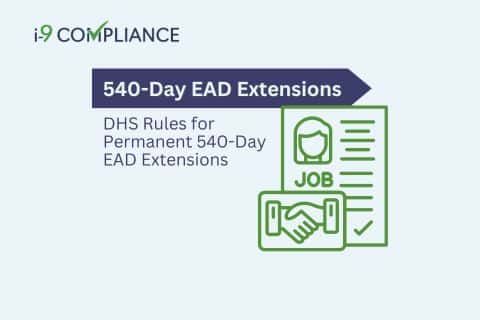DHS Rules for Permanent 540-Day EAD Extensions

The Department of Homeland Security (DHS) has published a final rule to make the 540-day automatic extension of expiring employment authorization documents permanent. Originally published in the Federal Register on December 13, 2024, the DHS scheduled the rule to take effect on January 13, 2025.
This permanent change to policy for employment authorization documents (EADs) will simplify the reverification of employment eligibility. It also helps prevent interruptions in work authorization. This policy follows two temporary final rules, which introduced the same 540-day extensions. These policies intended to help reduce the large backlogs that U.S Citizenship and Immigration Services (USCIS) has faced in recent years. The most recent temporary measure should end next year, which would introduce new challenges to the agency. According to the USCIS, it still struggles to eliminate ongoing backlogs of applications.
These extensions will apply to those who filed a timely renewal between May 4, 2022, and September 30, 2025. It also impacts those requesting a renewal in the same category as their expired EAD. However, anyone interested in the extensions must meet all eligibility requirements.
Categories eligible for the extension include:
- AO3
- AO5
- CO9
- A17
- C26
- A18
- C20
- C31
- A12
- C19
Though these extensions can last up to 540 days, they can end as soon as the USCIS issues its final decision. This decision may happen before the 540-day deadline. In addition, EADs issued under temporary protected status cannot extend past the “TPS Designated Through Date” in the applicable Federal Register Notice.
Individuals using these extensions must prepare all documents necessary for the employment eligibility verification (Form I-9) process. Such documents include the expired EAD and a receipt proving they filed an extension for a date within the eligible filing period. Employers must remember that they cannot require additional or specific documentation from the workers to complete the process.
Because the DHS has published this final rule so close to the change in administration, the fate of the rule has become uncertain. Some expect the next administration to either rescind or change the rule. Regardless, eligible workers should benefit from filing for an extension at the earliest opportunity.
Employers should also watch for regulatory changes to ensure they remain compliant. The best way to help ensure compliance with changes in the employment eligibility verification process is to use an electronic I-9 management tool with E-Verify integration. This tool will help guide HR personnel through the verification process and ensure proper storage of forms and documentation.
When it comes to your employees, automation makes eligibility verification quick and simple. Ensure compliance today with I-9 Compliance.